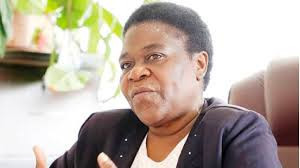THE heavy rains that have pounded most parts of Zimbabwe this week have left a trail of destruction, claiming one life and damaging infrastructure including schools amid concerns over the country’s state of preparedness during the rainy season.
The Meteorological Services Department (MSD) said rains accompanied by thunderstorms and violent winds, will continue across the country.
The heavy rains this week, which were accompanied by strong winds, wreaked havoc from the southern to northern regions of Zimbabwe, with Mberengwa and Chimanimani bearing the brunt of the violent storms.
The worst tragedy occurred at Zvemukonde Secondary School where the storm’s powerful winds blew off roofs of the buildings.
Unconfirmed reports indicate that the storm led to the death of a Grade 3 pupil and injured several others.
Reached for comment on the death of the pupil, national police spokesperson Commissioner Paul Nyathi said: “I only saw it on social media and on the television. I need to check with our police officers if they have received any report yet.”
Keep Reading
- Benzema confident Real will reach UCL final
- Rigging exposes widening Mnangagwa, Chiwenga rift
- Health talk: Mental health disorders and demolitions in Zimbabwe
- Munatsi family speaks on banker’s shock death
The storms have exposed government’s inadequate response and lack of preparedness in dealing with severe weather conditions.
Local Government and Public Works minister Daniel Garwe yesterday told a strategic planning workshop in Bulawayo that it was important to ensure that communities are adequately prepared to face natural disasters.
“This includes investing in early warning systems, emergency response training and creating robust disaster management plans at all levels,” Garwe said.
“Furthermore, we must recognise the significance of risk reduction. While we cannot prevent all disasters, we can certainly take measures to minimise their impact.
“This involves conducting thorough risk assessments, implementing land-use planning strategies and enforcing strict building by-laws.”
Meanwhile, Met Department head meteorologist James Ngoma told NewsDay yesterday that further storms are likely to pound the country in the coming days, with some areas, including Bulawayo, Masvingo and Kariba, at higher risk of floods.
“Areas likely to be affected by floods and thunderstorms are Bulawayo, Masvingo and Kariba,” Ngoma said.
“However, these can also occur in any area, we spoke of Mashonaland East and Manicaland as well.
“The reports are coming in because of the moisture that is spreading across the country.
“So no particular area is safe and no particular area is too prone. It is almost the entire field.
“We are going to have isolated showers as we get into Thursday and Friday and we only expect another system to enter again as we get into Tuesday and Wednesday next week.
“It will be more confined to the northern areas and then spread to the rest of the country.”
Ngoma said the system originated from the west, brought moisture from Botswana and swept across much of Zimbabwe.
“We had moisture that was drifting in from the west, that is through Botswana into Matabeleland North and South,” he said.
“It then swept across the country, giving us storms that reached parts of Mashonaland East, Central, Manicaland as well as Midlands. So we had thunderstorms in the entire country.
“We are expecting a few more storms before this system fades off into the weekend.
“For the next two days, we are expecting isolated afternoon thunder showers and this should be coupled with heavy down pours in a few places.
“We advise people to be alert, always remembering that when thunder roars, it’s best to be indoors.”
The government has in the past been on the spotlight after being accused of failing to adequately prepare or warn people before Cyclone Idai, which left 341 people dead and many others missing.
Meanwhile, teacher unions have called on the government to develop responsive context specific disaster risk management measures for each sector.
Amalgamated Rural Teachers Union of Zimbabwe president Obert Masaraure said such measures were beyond the general interventions of the Department of Civil Protection.
“Set up education emergeny committees at a community level so that school authorities may co-ordinate with stakeholders in the community to scope, raise alarm and reduce impact of disasters on the education system,” Masaraure said.
“Extreme weather conditions are going to be more frequent because of climate change.
“It is, therefore, imperative that Zimbabwe builds more resilient education systems with capacity to sustain provision of education during emergencies.”
Federation of Zimbabwe Educators Union of Zimbabwe president Akuneni Maphosa called on government to take a serious stance in terms of funding public education.
“Most of the school infrastructure particularly in the rural areas, especially those built before independence is generally weak and it is not up to standard,” Maphosa said.
“They do not match the current standards that are required for the classroom as of the current requirements.
“So, generally, such infrastructure is susceptible to destruction by winds, hailstorms and the rains and we are calling on government to take a serious stance in terms of funding public education in this country this involves budgetary allocations that are meaningful and that match international standards.”





